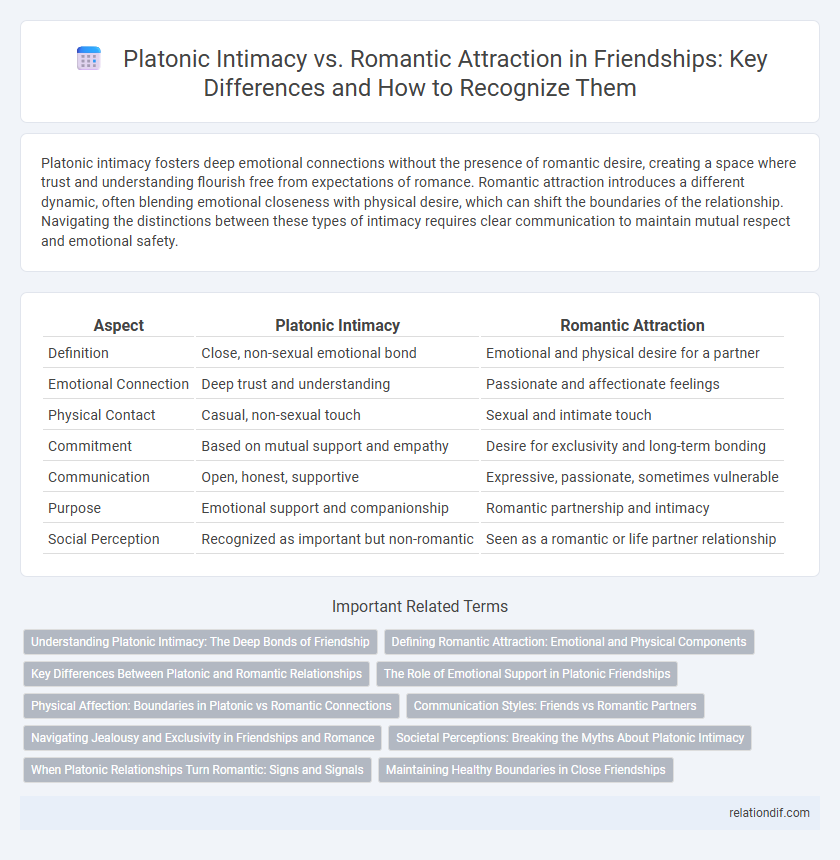Platonic intimacy fosters deep emotional connections without the presence of romantic desire, creating a space where trust and understanding flourish free from expectations of romance. Romantic attraction introduces a different dynamic, often blending emotional closeness with physical desire, which can shift the boundaries of the relationship. Navigating the distinctions between these types of intimacy requires clear communication to maintain mutual respect and emotional safety.
Table of Comparison
| Aspect | Platonic Intimacy | Romantic Attraction |
|---|---|---|
| Definition | Close, non-sexual emotional bond | Emotional and physical desire for a partner |
| Emotional Connection | Deep trust and understanding | Passionate and affectionate feelings |
| Physical Contact | Casual, non-sexual touch | Sexual and intimate touch |
| Commitment | Based on mutual support and empathy | Desire for exclusivity and long-term bonding |
| Communication | Open, honest, supportive | Expressive, passionate, sometimes vulnerable |
| Purpose | Emotional support and companionship | Romantic partnership and intimacy |
| Social Perception | Recognized as important but non-romantic | Seen as a romantic or life partner relationship |
Understanding Platonic Intimacy: The Deep Bonds of Friendship
Platonic intimacy encompasses emotional closeness and trust without romantic or sexual elements, forming the foundation of enduring friendships. This type of connection fosters support, empathy, and shared experiences, reinforcing strong social bonds. Understanding platonic intimacy involves recognizing its unique role in personal growth and emotional well-being distinct from romantic attraction.
Defining Romantic Attraction: Emotional and Physical Components
Romantic attraction involves both emotional and physical components that distinguish it from platonic intimacy. Emotionally, it includes feelings of deep affection, desire for exclusivity, and a longing for a shared future. Physically, it manifests as sexual attraction and a desire for closeness through touch and intimacy.
Key Differences Between Platonic and Romantic Relationships
Platonic intimacy centers on deep emotional connection and trust without sexual involvement, emphasizing mutual support and shared values. Romantic attraction combines emotional closeness with physical desire and passion, often involving exclusive commitments and future planning. Key differences lie in the presence of sexual intent, intensity of emotional expression, and expectations for long-term partnership.
The Role of Emotional Support in Platonic Friendships
Emotional support in platonic friendships fosters trust and deepens bonds without the complexities of romantic attraction, creating a safe space for vulnerability and understanding. This foundation strengthens mental well-being and resilience by offering consistent empathy and encouragement. Unlike romantic relationships, platonic emotional support emphasizes unconditional acceptance and shared experiences that reinforce mutual respect and loyalty.
Physical Affection: Boundaries in Platonic vs Romantic Connections
Physical affection in platonic intimacy typically includes gestures like hugging, light touches on the arm, or friendly pats, serving as expressions of support and closeness without romantic intent. Romantic attraction often involves more intense and frequent physical contact such as cuddling, hand-holding, or kissing, which convey deeper emotional and physical desire. Understanding and respecting boundaries in both platonic and romantic connections is vital to maintaining trust, comfort, and mutual respect between individuals.
Communication Styles: Friends vs Romantic Partners
Platonic intimacy relies on open, honest communication that emphasizes trust, understanding, and emotional support without the pressure of romantic expectations. Romantic partners often engage in more expressive and vulnerable dialogues, sharing desires, fears, and future plans that build deeper emotional and physical connections. Communication styles in friendships tend to prioritize comfort and stability, while romantic interactions frequently involve negotiation of boundaries and emotional intensity.
Navigating Jealousy and Exclusivity in Friendships and Romance
Navigating jealousy in friendships and romantic relationships requires recognizing the distinct boundaries between platonic intimacy and romantic attraction, ensuring mutual respect for emotional exclusivity without overstepping personal limits. Clear communication about expectations reduces misunderstandings and supports trust, while acknowledging individual needs helps maintain healthy connections free from possessiveness. Prioritizing empathy fosters a balanced dynamic where both friendships and romances thrive without jealousy undermining the bond.
Societal Perceptions: Breaking the Myths About Platonic Intimacy
Societal perceptions often conflate platonic intimacy with romantic attraction, leading to misunderstandings that undervalue deep, non-romantic bonds. Research in social psychology highlights that platonic intimacy fosters emotional support and trust without the complexities of romantic expectations. Dispelling myths about platonic relationships encourages healthier social connections and challenges the stereotype that close friendships must inevitably evolve into romantic partnerships.
When Platonic Relationships Turn Romantic: Signs and Signals
Signs that platonic relationships turn romantic include increased emotional vulnerability, frequent physical touch, and a shift in communication patterns such as deeper personal conversations. Experiencing jealousy or protective feelings when the friend interacts with others often signals emerging romantic attraction. Recognizing these changes early helps navigate the evolving dynamics between platonic intimacy and romantic desire.
Maintaining Healthy Boundaries in Close Friendships
Maintaining healthy boundaries in close friendships requires clear communication about personal limits and mutual respect for emotional space, distinguishing platonic intimacy from romantic attraction. Recognizing the difference between deep emotional connection and romantic feelings helps prevent misunderstandings and preserves trust. Establishing boundaries such as respecting time alone and avoiding ambiguous physical gestures supports sustained friendship without compromising emotional well-being.
Platonic Intimacy vs Romantic Attraction Infographic

 relationdif.com
relationdif.com